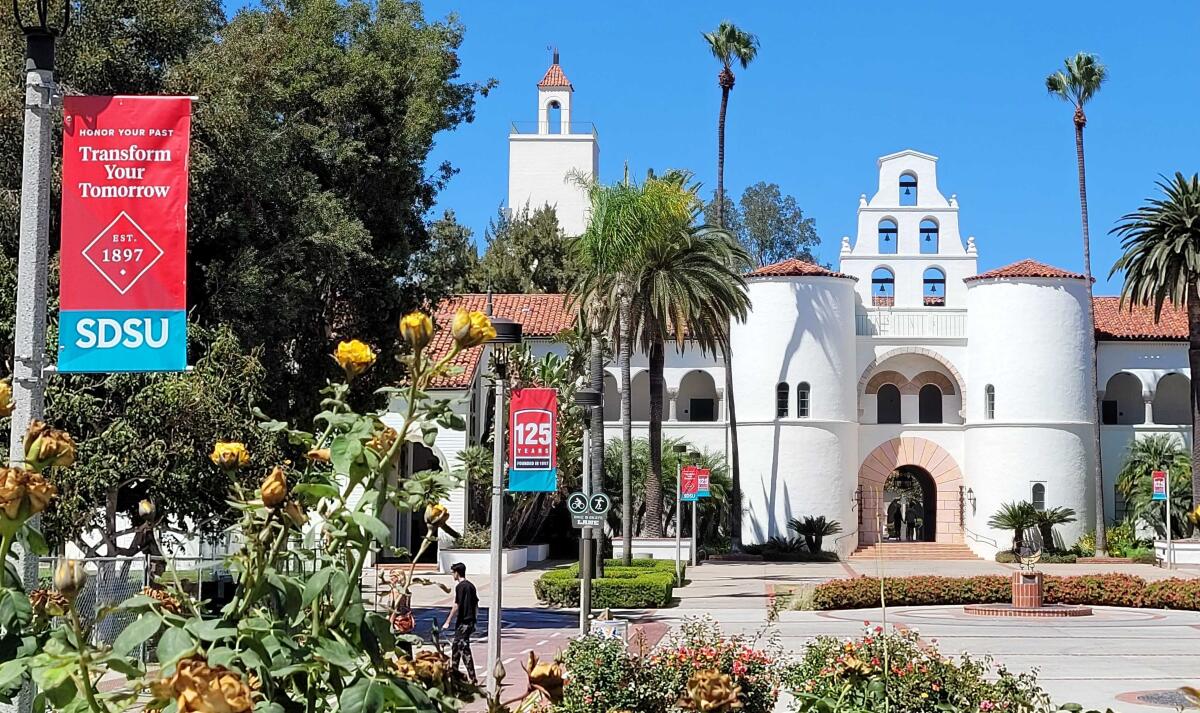As D.A. considers SDSU gang rape claims, experts explain why such cases are challenging

- Share via
SAN DIEGO — It has been about a month since police detectives handed over to prosecutors one of the most watched criminal investigations in the county — allegations that a 17-year-old high school student was gang-raped by San Diego State University football players.
It’s now up to the district attorney’s office to decide whether to file charges.
When prosecutors are evaluating these kinds of cases, they have to believe they have enough evidence to prove to a jury, beyond a reasonable doubt, that a crime was committed and that the accused is guilty.
This story is for subscribers
We offer subscribers exclusive access to our best journalism.
Thank you for your support.
Even after the #MeToo movement, with the societal attention and advancements it brought, struggles in investigating and prosecuting rape cases endure.
Believing the victim is only part of the equation. Alcohol or drugs may have been involved, potentially affecting the victim’s recall. Many suspects claim sexual encounters are consensual, and proving otherwise can be difficult.
High-profile cases carry added challenges with the public watching. People second-guess every investigative decision. Some see conspiracies and coverups and politics at every turn.
In this case, the high school student went to police to report she had been raped a day after she said it happened. Police quietly started investigating.
For months, even though there had been rumors on campus, the SDSU case lived under the radar. It was first made public in June when the Los Angeles Times reported that allegations of gang rape were being investigated — kicking up dust but revealing no details or names.
At the end of July, the young woman came forward and shared with reporters a harrowing tale of what she said was a 90-minute attack that left her bloodied, bruised and traumatized. She also feared the police investigation had stalled.
Within days, police finished their investigation and handed it to prosecutors for review.
Last month, the young woman, who is now 18, filed a lawsuit in San Diego Superior Court accusing three players on last year’s Aztecs football team by name, including one who’d just been drafted by the Buffalo Bills. Within two days, the NFL team cut him loose. The other two accused are no longer on the college team.
The players and their attorneys have either declined comment or flat-out denied the allegations. One of the attorneys cast doubt on the young woman’s recall of events; another called the civil suit “a money grab.”
Ten months after the young woman first approached police, handed over her bloodied clothes and underwent a rape examination, authorities remain mum and no charges have been filed.
In any rape case, there’s a lot for prosecutors to consider.
Belief and consent
When dealing with rape allegations in general, victim advocates say the biggest obstacle is that investigators and members of the public still struggle to believe people who report they’ve been raped.
Although efforts like #MeToo have helped bring awareness to the prevalence of sexual abuse, investigative agencies and members of the public still too often turn to victim blaming when women choose to report a rape, some experts say.
“What was she wearing, what was she drinking, what was she doing there — anyone should have the right to do any of those things and not be violated,” said Verna Griffin-Tabor, CEO of the Center for Community Solutions, the only rape crisis center in San Diego.
“Instead of holding a rapist, a perpetrator, accountable, many times people are asking about the actions of the victim, but nobody deserves that,” she said. “That behavior is unacceptable. It’s horrific.”
The young woman’s attorney, Dan Gilleon, has indicated there have been attempts to shame his client, and he said her family has been harassed. People have posted words and images online in an apparent effort to identify the young woman publicly.
The Union-Tribune does not publish the names of people identified as victims of rape or sexual assault without their permission.
And then there’s the matter of consent. Griffin-Tabor said she’s never seen a case that didn’t involve some claim that the act was consensual. Often, the question of whether a crime has occurred comes down to “he said” versus “she said.”
According to the lawsuit, the teen and friends had been drinking at other parties when they learned there was a party at a College Area home. They entered through a gate that took them to the backyard, and the teen became separated from her friends.
The lawsuit alleges she met Matt Araiza, then 21, who had sex with her in a side yard of the home and then led her to a bedroom where a group of men took turns raping her over the course of an hour and a half in the early morning of Oct. 17. Players Zavier Leonard and Nowlin “Pa’a” Ewaliko were part of the group, according to the lawsuit.
In April, Araiza had been drafted by the Buffalo Bills, who released him in late August after the civil suit was filed. That same day, Leonard, a redshirt freshman from Arlington, Texas, was dropped from the SDSU roster. Ewaliko left the Aztec team shortly before preseason practice started Aug. 5.
Araiza’s attorney, Kerry Armstrong, has said the allegations against Araiza are false, and that his client “definitely never went into that bedroom.”
Araiza’s parents issued a statement last week saying there had been “war waged on our son,” and that they and Araiza had been harassed.
Leonard’s attorney, Jamahl Kersey, declined to comment in detail last week, but said no one should jump to conclusions as to what the final outcome of the case will be.
Ewaliko’s attorney, Marc Carlos, said late last month that the young woman has said she cannot remember details of the incident. He called that “problematic.”
No criminal charges have been filed, and police have not named anyone as suspects.
What prosecutors consider
When prosecutors take a case, they often first evaluate the credibility of the complaining witness, said former prosecutor Samuel Dordulian, who spent 13 years as a deputy district attorney in Los Angeles County. Half of that time, he handled sex-crimes cases.
Prosecutors also look for independent corroboration, said Dordulian, who now represents sexual assault victims in civil cases. He said that can take many forms, including when, how and why the person made their first disclosure, and what they said.
That can also include pretext calls — a telephone call from the alleged victim to the accused and one of Dordulian’s “favorite devices” in an investigation. Law enforcement detectives listen in and record the conversation, and usually provide the victim a list of questions to ask and topics to cover in a bid to elicit information or an admission.
“You would be surprised how frequently we would get some form of admission, whether they would fully admit it or even where they would minimize it, which they would do frequently,” Dordulian said.
San Diego criminal defense attorney Gretchen von Helms , who is not involved in the SDSU case, said pretext calls can be “devastating” to the defense, depending on what the accused person says.
Police investigators used pretext calls in the SDSU investigation, according to the lawsuit. They coached the young woman on a variety of reasons for making the calls to people who may have been present, including fear of sexually transmitted diseases.
Dordulian said investigations can take months, but high-profile cases jump to the head of the line. And, he said, prosecutors are often assigned to collaborate with detectives before charges are filed in such cases.
Von Helms said police in this case should not be faulted for taking a long time to investigate, noting their need to go through a tremendous amount of digital evidence, including cameras and cellphones.
She said investigators had to figure out who might have been at the party, talk to them and maybe chase information from their cellphones and social media. Police, she said, have become good at finding digital evidence.
Once a case is in court, state law prevents defense attorneys from trying to shame the alleged victim with their previous sexual history or blame them for wearing clothing some would consider sexy. And, Von Helms said, the defense cannot be “I am man, I am weak. None of that.”
Von Helms cautioned the public against jumping to conclusions in a case where the evidence remains under wraps.
“There’s so many unknowns, we just have to wait,” she said. “It’s up to juries to make a decision. We don’t know all of the evidence. We don’t know what happened.
“It’s important to give these kids in the criminal case the presumption of innocence.”
Echoes from 25 years ago
A case from 25 years ago, also involving SDSU football players, illustrates some of the complexities that can arise in rape investigations.
In early March 1997, an 18-year-old high school student reported to San Diego police she had been raped by five men during a small Sunday gathering at a house not far from the SDSU campus.
She told detectives she drank wine and smoked marijuana with some of them. She said she blacked out several times and was sexually assaulted by the men. And she said she could identify four of them, including three who were Aztec football players.
Police investigated for five months, releasing very little information to the public. University officials were mostly mum, too. That summer, three football players were arrested on suspicion of rape and jailed. The story drew media attention from across the country.
Two days later, prosecutors declined to file charges and the men were released.
The case was not filed, according to prosecutors, because detectives made the arrests before testing had been completed on DNA evidence collected during the investigation. Those results didn’t match samples voluntarily provided by two of the players.
That and other suspect-identification problems — the woman picked people out in photo lineups who were not at the house — cast doubt on her version of events, officials said.
“Nobody doubted the sincerity of the victim, but her ability to accurately relate what had transpired and who was involved was undercut by the DNA and other evidence,” said Paul Pfingst, who was district attorney at the time.
‘There’s a lot involved’
Pfingst, now in private practice as a defense attorney, said there have been changes in the way rape cases are handled since the 1997 investigation.
Police are more careful now about waiting for the results of DNA and other tests before making arrests, he said. There is less “victim shaming” in courtrooms.
“Cases with multiple parties are often difficult,” Pfingst said, referring to the people accused of the crimes. “Does the forensic evidence match the memory of the victim? When there are multiple people, and alcohol or drugs are involved, misidentifications can be a problem.”
Pfingst said the length of time it’s taken for police to investigate the current case and for prosecutors to evaluate it feels “a little long” to him. But not that surprising.
“There’s a lot involved in a case like this,” Pfingst said, “and it takes time to process things.”
DNA evidence can get thorny, especially if there are multiple suspects. Digital images and the social media activity of both the victim and the suspects have to be located and analyzed.
Factor in the age of the victim, the celebrity of the football players, the influence of #MeToo on potential jurors and “the dynamics are much more complicated than they used to be,” he said.
When Joanne Archambault and her husband heard of the most recent allegations against San Diego State football players, he said to her, “It’s like déjà vu.”
The former police sergeant supervised San Diego Police Department’s sex crimes unit for 10 years. Her team handled thousands of cases in that time — including the 1997 SDSU case.
In 2003, Archambault founded the nonprofit End Violence Against Women International. Its aim is to improve criminal justice responses to sexual assault and other forms of gender-based violence, namely through training and public service campaigns.
Progress has been made, she said. Investigating agencies have made great strides in connecting with marginalized groups like undocumented immigrants and members of the LGBTQ population. Forensic technology is much more sophisticated than it used to be.
But to this day, prosecution rates remain low, she said.
At the core of the difficulty? “Victims still aren’t being believed,” Archambault said. “It’s a huge problem.”
Archambault’s organization launched the Start by Believing campaign in 2011. The program is designed to help law enforcement agencies and the public respond better when people report a sexual assault.
The district attorney’s office was not immediately able to say how many rape cases submitted to the office result in charges being filed. An annual review showed the office prosecuted 420 sex offenses, including rape, last year.
According to San Diego Police statistics, 571 rapes were reported across the city in 2021. The rape clearance rate, which measures how often cases are solved by arrest or closed because of circumstances outside the control of investigators, was 10.5%.
The national rape clearance average in 2019, the year data is most recently available, was about 33%. San Diego’s rape clearance rate that year was 20.5%.
More to Read
Sign up for Essential California
The most important California stories and recommendations in your inbox every morning.
You may occasionally receive promotional content from the Los Angeles Times.













